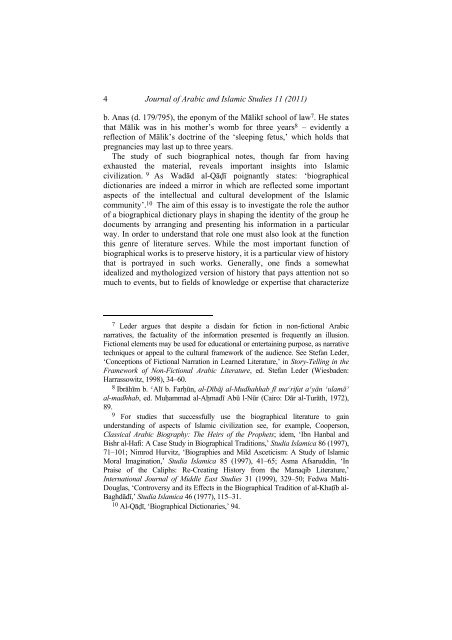JOURNAL OF ARABIC AND ISLAMIC STUDIES
JOURNAL OF ARABIC AND ISLAMIC STUDIES
JOURNAL OF ARABIC AND ISLAMIC STUDIES
You also want an ePaper? Increase the reach of your titles
YUMPU automatically turns print PDFs into web optimized ePapers that Google loves.
4<br />
Journal of Arabic and Islamic Studies 11 (2011)<br />
b. Anas (d. 179/795), the eponym of the Mālikī school of law 7 . He states<br />
that Mālik was in his mother’s womb for three years 8 – evidently a<br />
reflection of Mālik’s doctrine of the ‘sleeping fetus,’ which holds that<br />
pregnancies may last up to three years.<br />
The study of such biographical notes, though far from having<br />
exhausted the material, reveals important insights into Islamic<br />
civilization. 9 As Wadād al-Qāḍī poignantly states: ‘biographical<br />
dictionaries are indeed a mirror in which are reflected some important<br />
aspects of the intellectual and cultural development of the Islamic<br />
community’. 10 The aim of this essay is to investigate the role the author<br />
of a biographical dictionary plays in shaping the identity of the group he<br />
documents by arranging and presenting his information in a particular<br />
way. In order to understand that role one must also look at the function<br />
this genre of literature serves. While the most important function of<br />
biographical works is to preserve history, it is a particular view of history<br />
that is portrayed in such works. Generally, one finds a somewhat<br />
idealized and mythologized version of history that pays attention not so<br />
much to events, but to fields of knowledge or expertise that characterize<br />
7 Leder argues that despite a disdain for fiction in non-fictional Arabic<br />
narratives, the factuality of the information presented is frequently an illusion.<br />
Fictional elements may be used for educational or entertaining purpose, as narrative<br />
techniques or appeal to the cultural framework of the audience. See Stefan Leder,<br />
‘Conceptions of Fictional Narration in Learned Literature,’ in Story-Telling in the<br />
Framework of Non-Fictional Arabic Literature, ed. Stefan Leder (Wiesbaden:<br />
Harrassowitz, 1998), 34–60.<br />
8 Ibrāhīm b. ʿAlī b. Farḥūn, al-Dībāj al-Mudhahhab fī maʿrifat aʿyān ʿulamāʾ<br />
al-madhhab, ed. Muḥammad al-Aḥmadī Abū l-Nūr (Cairo: Dār al-Turāth, 1972),<br />
89. 9 For studies that successfully use the biographical literature to gain<br />
understanding of aspects of Islamic civilization see, for example, Cooperson,<br />
Classical Arabic Biography: The Heirs of the Prophets; idem, ‘Ibn Hanbal and<br />
Bishr al-Hafi: A Case Study in Biographical Traditions,’ Studia Islamica 86 (1997),<br />
71–101; Nimrod Hurvitz, ‘Biographies and Mild Asceticism: A Study of Islamic<br />
Moral Imagination,’ Studia Islamica 85 (1997), 41–65; Asma Afsaruddin, ‘In<br />
Praise of the Caliphs: Re-Creating History from the Manaqib Literature,’<br />
International Journal of Middle East Studies 31 (1999), 329–50; Fedwa Malti-<br />
Douglas, ‘Controversy and its Effects in the Biographical Tradition of al-Khaṭīb al-<br />
Baghdādī,’ Studia Islamica 46 (1977), 115–31.<br />
10 Al-Qāḍī, ‘Biographical Dictionaries,’ 94.

















